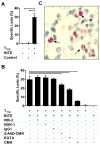Human regulatory T cells kill tumor cells through granzyme-dependent cytotoxicity upon retargeting with a bispecific antibody
- PMID: 24570975
- PMCID: PMC3932050
- DOI: 10.1158/2326-6066.CIR-13-0049
Human regulatory T cells kill tumor cells through granzyme-dependent cytotoxicity upon retargeting with a bispecific antibody
Abstract
A major mechanism by which human regulatory T cells (T(regs)) have been shown to suppress and kill autologous immune cells is through the granzyme-perforin pathway. However, it is unknown whether T(regs) also possess the capacity to kill tumor cells using similar mechanisms. Bispecific antibodies (bscAbs) have emerged as a promising class of therapeutics that activate T cells against tumor antigens without the need for classical MHC-restricted TCR recognition. Here, we show that a bscAb targeting the tumor-specific mutation of the epidermal growth factor receptor, EGFRvIII, redirects human CD4(+)CD25(+)FoxP3(+) T(regs) to kill glioblastoma (GBM) cells. This activity was significantly abrogated by inhibitors of the granzyme-perforin pathway. Notably, analyses of human primary GBM also displayed diffuse infiltration of granzyme-expressing FoxP3(+) T cells. Together, these data suggest that despite their known suppressive functions, tumor-infiltrating T(regs) possess potent cytotoxic mechanisms that can be co-opted for efficient tumor cell lysis.
Keywords: Bispecific Antibodies; Glioblastoma; Granzymes; Immunomodulation; Regulatory T Cells.
Conflict of interest statement
Conflict of Interest Statement: The authors B.D.C., D.D.B. and J.H.S. have a patent pending for EGFRvIII as a tumor-specific target for bispecific antibody therapy.
Figures



References
-
- Stupp R, Hegi ME, Mason WP, van den Bent MJ, Taphoorn MJ, Janzer RC, et al. Effects of radiotherapy with concomitant and adjuvant temozolomide versus radiotherapy alone on survival in glioblastoma in a randomised phase III study: 5-year analysis of the EORTC-NCIC trial. Lancet Oncol. 2009;10:459–66. - PubMed
-
- Zou W. Immunosuppressive networks in the tumour environment and their therapeutic relevance. Nat Rev Cancer. 2005;5:263–74. - PubMed
-
- Grossman WJ, Verbsky JW, Barchet W, Colonna M, Atkinson JP, Ley TJ. Human T regulatory cells can use the perforin pathway to cause autologous target cell death. Immunity. 2004;21:589–601. - PubMed
-
- Gondek DC, Lu LF, Quezada SA, Sakaguchi S, Noelle RJ. Cutting edge: contact-mediated suppression by CD4+CD25+ regulatory cells involves a granzyme B-dependent, perforin-independent mechanism. J Immunol. 2005;174:1783–6. - PubMed
Publication types
MeSH terms
Substances
Grants and funding
LinkOut - more resources
Full Text Sources
Other Literature Sources
Research Materials

